Chapter 01: Loving yourself and others
Introduction
When you were in Standard Four, you learnt how to love yourself and others. In this chapter, you will learnt about acts that show love for people with special needs and how to dress properly on various public occasions in accordance with Tanzanian culture.
Love is caring for yourself and others. We usually say that true love has no limits. Therefore, we are supposed to love ourselves and others equally. People with special needs need more love because of their social and physical conditions. Accordingly, we are not supposed to hurt them by our acts. Examples of such people are the aged, disabled, poor, and orphans.
Look at the following picture and answer the questions that follow.
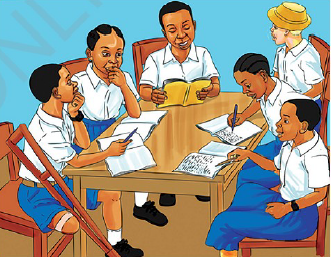 Figure 1: Pupils studying together |
| Exercise 1. Which pupil in the picture have special needs? 2 What kind of assistance do those pupils need? 3. What are the advantages of cooperating with people who need special care? 4 What will you do to your fellow pupils who are blind 5. What otter acts can you do to pupils both special needs for them not to feel lonely? |
Most of the time, people fail to differentiate between sex and gender. There is a clear difference between sex and gender. The word "sex" means a biological difference between a male and a female. Sex roles and responsibilities do not change because of the genetic make-up.
Look at the table below which differentiates sex.
Table 1: Differences in sex
| Women | Men |
| Get pregnancy | Cause pregnancy |
| Have menstrual circles | No menstrual circles |
| Have breasts for feeding children | Have no breasts for feeding children |
Gender refers to the roles and responsibilities of men and women that are created in our families, our societies and our cultures. It includes the expectations held about the characteristics, aptitudes and likely behaviours of both women and men. Also gender refers to the relationship between girls and boys, women and men, and even parents and children that are created in our families, communities and other institution. It includes differential expectations about roles and responsibilities, what we look like, how we dress, and what kind of abilities we have. Girls and boys learn different ways of behaving from their relatives, teachers, friends and other people, and often conform in order to fit in. Gender relationships often lead to different kinds of games, for example football for boys and netball for girls. Also gender relationship leads to different kinds if jobs at home like cooking for girls and tending cattle for boys.
Gender roles refer to roles and responsibilities done by either men or women in a given society. Although women and men differ physically, they can help each other to fulfill various duties. For example, both can be good leaders. Gender differences can be addressed by respecting human rights. Various actions can show respect for gender and sex.
Consider the following statements and mention the acts of respect for each other:
(i) A female pupil assists a male pupil to do calculations in Mathematics.
(ii) Male and female pupils wash utensils.
(iii) A male pupil is helping a female pupil to get a bucket of water off her head.
(iv) A male pupil refuses to sit between two female pupils.
(v) Pupils are quarreling and using abusive language.
Acts showing gender equality
(i) Providing equal education to both females and males
(ii) Understanding that both boys and girls are equal because they are human beings
(iii) Avoiding gender discrimination in doing work at home and at school
 |
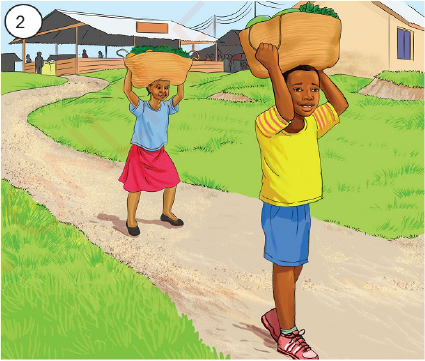 |
| Figure 2 Acts of gender equality |
As you grow up, you will pass through different stages. Each stage requires you to be self-aware, accountable, and respectful. A good example is the puberty stage for boys and girls. This is the period of physical and mental maturity. This stage is associated with feelings which may cause negative impact on your personality. Therefore, it is better to think before doing or speaking anything. Your language should not offend others of the opposite sex; likewise, your acts should not make others feel bad or uncomfortable.
It is good to establish positive relationships between girls and boys by respecting the boundaries of such relationships and the dignity of others. For example, it is not good to laugh at your friends because they are going through puberty or menstruation. In addition, it is not good to use offensive language to others, to touch one's sexual parts, and to discriminate others. Normally, when a boy or a girl is in puberty, his or her body starts experiencing changes. For example, the girl starts to experience pimples and scabies; the menstruation circle then begins; breasts enlarge, and the girl is now able to get pregnancy. Likewise, the boy starts to experience pimples on his face; the voice changes; he experiences wet dreams, and he can cause pregnancy.
In order to avoid negative impacts, every sex should be responsible and take care of themselves by knowing that it is not the time to be involved in love affairs. During this period, you should learn how to control your feelings to avoid immoral acts. Stay away from unsafe and threatening environments such as passing alone through narrow alleys at night or even during the day and roaming around. Girls are advised to refrain from receiving gifts from people of the opposite sex.
Read the following passage and answer the questions that follow.
Anna was a very intelligent girl in her class. She was charming. She was participating fully in sports and in various traditional dances at school. She had friends with whom she used to play. As she reached Standard Five, she suddenly changed. One day, her school uniform (skirt) was seen stained with blood. Her friends laughed at her, and boys stained whispering. One boy winked mischievously at her. Anna stained to feel embarrassed; her charming attitude decreased and she was not participating well in class and sport as she used to do. She started isolating herself from others and stopped cooperating with them.
Exercise
1. What kind of a girl was Anna before?
2. What changes did Anna get?
3. What acts were done to Anna against her rights?
4. What advice do you give to pupils like Anna's classmates who disrespected her?
5. What is the difference between sex and gender?
6. Mention acts that, when are done to you, would imply gender oppression.
7. Outline acts done at school showing gender equality.
8. Mention the acts that show respect for the other sex.
9. Outline acts done at home that do not show gender equality.
10. Differentiate between sexual harassment and gender oppression.
| Activity Discuss with your parents or guardians the domestic activities that you can do regardless of your sex. Outline those activities and submit your work to your subject teacher. |
Dressing well on different occasions
| Think What kind of clothes do you prefer to wear most of your time? What dressing style shows respect? |
Dressing styles define who we are. Proper dressing reflects good behaviour and respect. Normally, girls should wear long dresses or gowns which do not show their body parts, a good blouse which does not expose her breasts or belly, and long trousers which are not tight around the hips. Boys are supposed to wear unlighted trousers and which are not torn all over. They should also not wear their trousers below the waist (sagging pants).
Proper dressing on different occasions is very important. For example, people are required to dress properly when they go to church, mosque or school. In sports, they usually put on sportswear. Some clothes can be worn by both sexes. Such clothes are trousers, shorts, and jackets. However, a boy cannot wear gowns or skirts. In addition, the climatic condition can determine the type of clothes to be worn. Some clothes can be worn in cold conditions while others in warm conditions. The types of clothes to be worn in cold conditions are jackets, sweaters, long-sleeved shirts, and suits. Examples of clothes to be worn in warm conditions are long and short trousers as well as long and short sleeved shirts for men; long dresses for women, also known as baibui; and long dresses for men, also known as kanzu.
Look at the following pictures and answer the questions that follow.
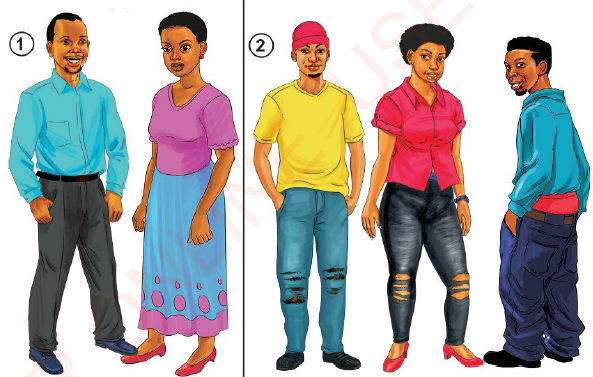 Figure 3: Proper and improper dressing in accordance with dressing codes |
Traditional dress codes
Traditional dress codes are kinds of dress codes which define a particular society or tribe. Some clothes represent different cultures. Those clothes are like lubega for Maasai, kanzu, msuli, coat and baraghashia for the coastal people. Some dress codes are special for traditional leaders like chiefs; for example, chiefs of the Ngoni people and the Hehe usually put on migolole. In addition, there are special clothes for traditional dancing. Examples are white shorts and white shirts which are usually worn by the Nyasa. Another examples is kaniki worn by the Gogo.
Due to world development and globalization, Tanzania has become a market for different dress styles from different places around the world. Although the impacts of globalization are inevitable, we are supposed to choose proper dressing styles which do not show disrespect for our people.
Look at the following pictures and answer the questions that follow.
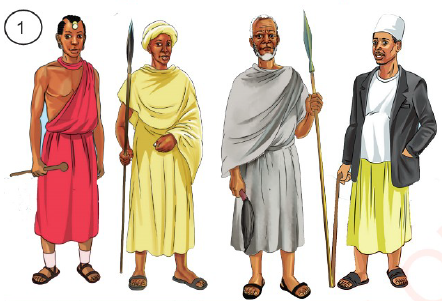 |
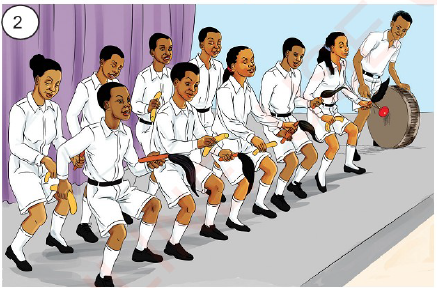 |
| Figure 4: Traditional dress codes |
Exercise
1. Mention your tribe's dress code.
2. Which society wears the traditional clothes shown in picture 2 when performing their traditional dance?
3. Mention two advantages of traditional clothing.
4. Mention two impacts of adopting foreign dressing styles on your society.
| Activity Discuss with your fellow pupils the improper dressing styles worn by people in your society and how you are going to advise them. Write the decision in your exercise book and submit it to your subject teacher. |
Exercise
Write True for a true statement and False for a false one in each of the following.
1. True love is all about loving yourself . . . . . . . . . .
2. People with disability are a special group . . . . . . . . .
3. One of the needs of human beings is love . . . . . . . . .
4. Gender roles change. . . . . . . . . . .
5. Gender roles change due to the perception of the society. . . . . . . . . . .
6. Children of both sexes should be respected, and they should respect themselves . . . . . . .
7. All men do not cook at home . . . . . . . . . . .
8. Proper dressing behaviour means not following fashion trends. . . . . . . . . . .
9. Some clothes are worn by both men and women . . . . . . . . . .
10. Lubega is not a dress code worn by the Maasai people . . . . . . . . . . . .
Vocabulary
- Kaniki : a piece of black coloured cloth with cotton material worn by women instead of Khanga or Kitenge
- Location a place where something happens or is situated
- Manage : to seize something under strict control
- Menstruation : the discharge of blood which a girl or woman
 experiences every month
experiences every month - Mgolole : a long sheet of cloth that is usually worn by traditional leaders
- Obedience : respect and trustworthiness
- Personality : proper and attractive behaviour that inspires people to respect others
- Puberty : the biological body changes to either a girl or a boy entering maturity (Adulthood)
www.learninghubtz.co.tz
Hub App
 For Call,Sms&WhatsApp: 255769929722 / 255754805256
For Call,Sms&WhatsApp: 255769929722 / 255754805256
 For Call,Sms&WhatsApp: 255769929722 / 255754805256
For Call,Sms&WhatsApp: 255769929722 / 255754805256
WHATSAPP US NOW FOR ANY QUERY
App Ya Learning Hub Tanzania






